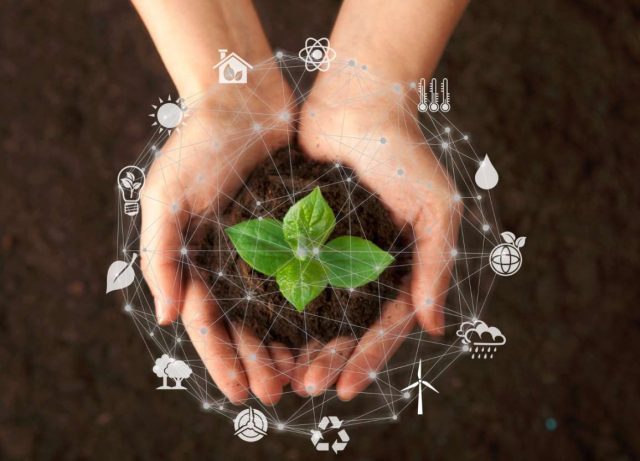There is an old saying that charity begins at home. Creating a world that’s healthier for you, your family, and the environment begins at home as well.
You don’t have to live off the land to make a difference. Every time one person performs one action that’s better for the Earth, it creates a ripple. Collectively, single actions can create a tsunami of good.
Home is where you have the most control over what you consume, use, and do. Why not begin there? Here are three simple ways to foster a holistic and sustainable household.
1. Eat Better
Take a look in your pantry, fridge, and freezer. You’ll likely find them chock-full of processed and refined foods. If you want a more holistic diet, you need to start replacing them.
Commit to buying fresh fruits and vegetables as often as possible. Even better, buy what’s grown locally instead of harvested before ripening and shipped from another hemisphere. It may cost you a little more, but your health and the planet will benefit from the investment.
You don’t have to become a vegan and give up meat forever, but you can limit your meat and poultry intake. Opting for wild-caught fresh fish like salmon, shellfish, or the local catch of the day will help. Just be sure to avoid any fish that contains significant amounts of mercury, like swordfish.
Don’t forget to explore plant-based protein as a healthy and sustainable option. Meat production is resource-intensive and causes hundreds of billions of pounds of methane emissions every year. By replacing some of the meat in your diet with plant-based alternatives, you’ll do the planet good.
A more holistic diet is far healthier for you and your family. And eating sustainably has environmental, social, and economic benefits. Start with a few changes and see where they take you.
2. Wear (and Furnish) Better
Garments and textiles may be the last things you think about when you ponder sustainability. But consider for a minute how many of them you have in your home. From the clothes on your back to the curtains on your windows to the rugs on your floors, they’re everywhere.
Polyester sheds plastic microfibers while it’s worn, used, and walked on, and everything that breathes inhales them. Those microfibers are also entering water systems from washing machines and groundwater from landfills, going on to endanger wildlife. Worse yet, polyester and rayon take centuries to break down in landfills, releasing methane all the while. And that’s an even more potent greenhouse gas than carbon dioxide.
Fabrics like cotton, silk, linen, and wool are not only organic and sustainable, but they break down quickly and cleanly in landfills. Wool carpets may be pricier than polyester, but they last longer in your home and don’t cause microfiber pollution. If you can’t swing the cost, at least buy synthetic carpets made from recycled carpets and rugs.
Rayon, used in abundance, is a semi-synthetic. It’s made from wood cellulose, like bamboo, but requires a heavy dose of chemical processing. Rayon may give you the look and feel of silk without the price, but as noted above, there’s another price to pay.
Instead of just checking the price tag, check out the label instead. The more you can stick with organic fabrics and avoid the chemicals, the better. Microplastics are everywhere, but you can shut the front door on them if you choose to do so.
3. Clean Better
You may think you’re keeping your home spic and span, but have you read the labels on your cleaning products? Those that are not formulated to be environmentally friendly usually contain harsh chemicals and toxins. They can cause health issues, including burns and breathing problems, and they can poison kids and pets if they ingest them.
Fortunately, you can keep your home clean while avoiding the harm to humans and pets in the household and the environment. There are increasing numbers of green cleaning products on the market. Or you can whip one up with some safe ingredients you probably use to cook and bake with.
Look for products that are biodegradable, non-toxic, and free of manufactured fragrances, dyes, chlorine, and phosphates. Many products come in recycled, recyclable, and/or minimal packaging. Others have refill options so you can keep using the same sprayers and bottles time after time.
If you don’t want to pay for these green products, pull out your white vinegar, baking soda, and tea tree oil. You’re probably aware of the danger of creating a deadly gas by mixing bleach with ammonia. But you can throw baking soda down a slow drain, add vinegar, and watch it bubble and break down clogs.
Remember, the products you use to keep things clean don’t just affect the air and surfaces of your household. They also affect greenhouse gas emissions in production and water supplies when they come out the other end. Save your health, your money, and the environment by using safe and easy homemade alternatives.
Do Better, One Small Choice at a Time
You have no doubt heard the triple-R advice to “reduce, reuse, and recycle.” If you start living by that mantra, you will create a holistic and sustainable household. If everyone made a few deliberate choices in their diet, fabrics, and cleaning products, it would make a major impact.
Make thoughtful and deliberate choices for the better at every opportunity. Consider swapping your K-Cups for compostable pods and donating items rather than discarding them. Be mindful and start making a r-r-ripple from the inside of your home on out.

Speaks from heart, always too passionate and driven by emotions. Spins the words with kindness & sharpness, intriguing your ever-inscrutable minds.


